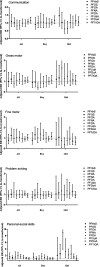Prenatal plasma concentrations of Perfluoroalkyl and polyfluoroalkyl substances and neuropsychological development in children at four years of age
- PMID: 31196101
- PMCID: PMC6567504
- DOI: 10.1186/s12940-019-0493-3
Prenatal plasma concentrations of Perfluoroalkyl and polyfluoroalkyl substances and neuropsychological development in children at four years of age
Abstract
Objective: Perfluoroalkyl and polyfluoroalkyl substances (PFASs) are persistent pollutants and have endocrine disruptive and neurotoxic effects. The association between maternal PFAS concentrations and neuropsychological development in children is inconclusive. The present study aimed to examine the effect of maternal PFAS concentrations on neuropsychological development in 4-years-old children.
Methods: We used data from Shanghai-Minhang Birth Cohort, which recruited pregnant women at 12-16 gestational weeks. Among 981 women having PFAS measurement, 533 mother-child pairs were included in the study. A total of eight PFASs were measured, including perfluorooctane sulfonate (PFOS), perfluorooctanoic acid (PFOA), perfluorohexane sulfonate (PFHxS), perfluorononanoic acid (PFNA), perfluorodecanoic acid (PFDA), perfluoroundecanoic acid (PFUdA), perfluorododecanoic acid (PFDoA), and perfluorotridecanoic acid (PFTrDA). When infants turned 4 years old, mothers were asked to complete the Ages and Stages Questionnaires® (ASQ) to assess neuropsychological development of their children. Poisson regression model with robust variance estimates was used to examine the association between maternal PFAS concentrations and each developmental subscale of the ASQ.
Results: Prenatal plasma concentrations of most PFASs tended to be associated with increased risk of development problem in personal-social skills, including PFHxS, PFOS, PFOA, PFNA, PFDA, and PDUdA, and the associations for PFNA and PFDA were significant (per natural log unit increase: RRPFNA = 1.92, 95% CI: 1.21, 3.05; RR PFDA = 1.66, 95% CI: 1.17, 2.37). In stratified analyses by child' sex, the consistent pattern of higher risk of developmental problems in personal-social skills associated with most PFASs was mainly observed among girls (RRPFOS = 2.56, 95% CI: 1.20, 5.45; RRPFOA = 9.00, 95% CI: 3.82, 21.21; RRPFNA = 3.11, 95% CI: 1.36, 7.13; RRPFDA = 2.20, 95% CI: 1.21, 4.00; RRPFUdA = 2.44, 95% CI: 1.14, 5.20; RRPFDoA = 1.62, 95% CI: 1.04, 2.54). Boys with higher maternal PFOA concentrations had a decreased risk of developmental problems in gross motor skills (RR = 0.47, 95% CI: 0.25, 0.89).
Conclusion: Prenatal plasma PFAS concentrations were associated with neuropsychological development in girls at 4 years of age, mainly in the subset of personal-social skills.
Keywords: Age and stage questionnaire; Neuropsychology; Perfluoroalkyl and polyfluoroalkyl substances; Prenatal concentrations.
Conflict of interest statement
The authors declare that they have no competing interests.
Figures
Similar articles
-
Concentrations of perfluoroalkyl and polyfluoroalkyl substances and blood glucose in pregnant women.Environ Health. 2020 Aug 17;19(1):88. doi: 10.1186/s12940-020-00640-8. Environ Health. 2020. PMID: 32807188 Free PMC article.
-
Maternal plasma concentrations of perfluoroalkyl and polyfluoroalkyl substances during pregnancy and anogenital distance in male infants.Hum Reprod. 2019 Jul 8;34(7):1356-1368. doi: 10.1093/humrep/dez058. Hum Reprod. 2019. PMID: 31242507
-
Determinants of plasma concentrations of perfluoroalkyl and polyfluoroalkyl substances in pregnant women from a birth cohort in Shanghai, China.Environ Int. 2018 Oct;119:165-173. doi: 10.1016/j.envint.2018.06.015. Epub 2018 Jun 27. Environ Int. 2018. PMID: 29958117
-
Systematic review and meta-analysis of epidemiologic data on vaccine response in relation to exposure to five principal perfluoroalkyl substances.Environ Int. 2023 Feb;172:107734. doi: 10.1016/j.envint.2023.107734. Epub 2023 Jan 7. Environ Int. 2023. PMID: 36764183
-
The association between maternal perfluoroalkyl substances exposure and early attention deficit hyperactivity disorder in children: a systematic review and meta-analysis.Environ Sci Pollut Res Int. 2021 Dec;28(47):67066-67081. doi: 10.1007/s11356-021-15136-2. Epub 2021 Jul 9. Environ Sci Pollut Res Int. 2021. PMID: 34244930
Cited by
-
Exposure to endocrine disrupting chemicals impacts immunological and metabolic status of women during pregnancy.Mol Cell Endocrinol. 2023 Nov 1;577:112031. doi: 10.1016/j.mce.2023.112031. Epub 2023 Jul 26. Mol Cell Endocrinol. 2023. PMID: 37506868 Free PMC article. No abstract available.
-
Effects of Early-life PFAS Exposure on Child Neurodevelopment: A Review of the Evidence and Research gaps.Curr Environ Health Rep. 2025 Jan 31;12(1):9. doi: 10.1007/s40572-024-00464-5. Curr Environ Health Rep. 2025. PMID: 39888511 Free PMC article. Review.
-
Perfluoroalkyl Substance Exposure and the BDNF Pathway in the Placental Trophoblast.Front Endocrinol (Lausanne). 2021 Jul 28;12:694885. doi: 10.3389/fendo.2021.694885. eCollection 2021. Front Endocrinol (Lausanne). 2021. PMID: 34394001 Free PMC article.
-
Prenatal and perinatal exposure to Per- and polyfluoroalkyl substances (PFAS)-contaminated drinking water impacts offspring neurobehavior and development.Sci Total Environ. 2024 Mar 20;917:170459. doi: 10.1016/j.scitotenv.2024.170459. Epub 2024 Jan 28. Sci Total Environ. 2024. PMID: 38290673 Free PMC article.
-
Neuromotor effects of early-life exposure to a mixture of endocrine disruptors in Belgian preschool children.Environ Health. 2025 Mar 17;24(1):11. doi: 10.1186/s12940-025-01156-9. Environ Health. 2025. PMID: 40091032 Free PMC article.
References
-
- Olsen GW, Burris JM, Ehresman DJ, Froehlich JW, Seacat AM, Butenhoff JL, Zobel LR. Half-life of serum elimination of perfluorooctanesulfonate, perfluorohexanesulfonate, and perfluorooctanoate in retired fluorochemical production workers. Environ Health Perspect. 2007;115(9):1298–1305. doi: 10.1289/ehp.10009. - DOI - PMC - PubMed
-
- Apelberg BJ, Witter FR, Herbstman JB, Calafat AM, Halden RU, Needham LL, Goldman LR. Cord serum concentrations of perfluorooctane sulfonate (PFOS) and perfluorooctanoate (PFOA) in relation to weight and size at birth. Environ Health Perspect. 2007;115(11):1670–1676. doi: 10.1289/ehp.10334. - DOI - PMC - PubMed
MeSH terms
Substances
Grants and funding
- 2018YFC1002801/the National Key Research and Development Program of China/International
- 2016YFC1000505/the National Key Research and Development Program of China/International
- 2017YFC1600500/the National Key Research and Development Program of China/International
- 16ZR1430100/the Science and Technology Commission of Shanghai Municipality/International
- 21628701/the National Natural Science Foundation of China/International
- 201840184/Shanghai municipal health commission/International
- 2018KY812/Health Commission of Zhejiang Province/International
- 2016BY58088/Health Commission of Jiaxing City/International
- 2016A05/Health Commission of Jiaxing City/International
- CX2017-06/Innovation-oriented Science and Technology Grant from NHC Key Laboratory of Reproduction Regulation/International
LinkOut - more resources
Full Text Sources
Medical


